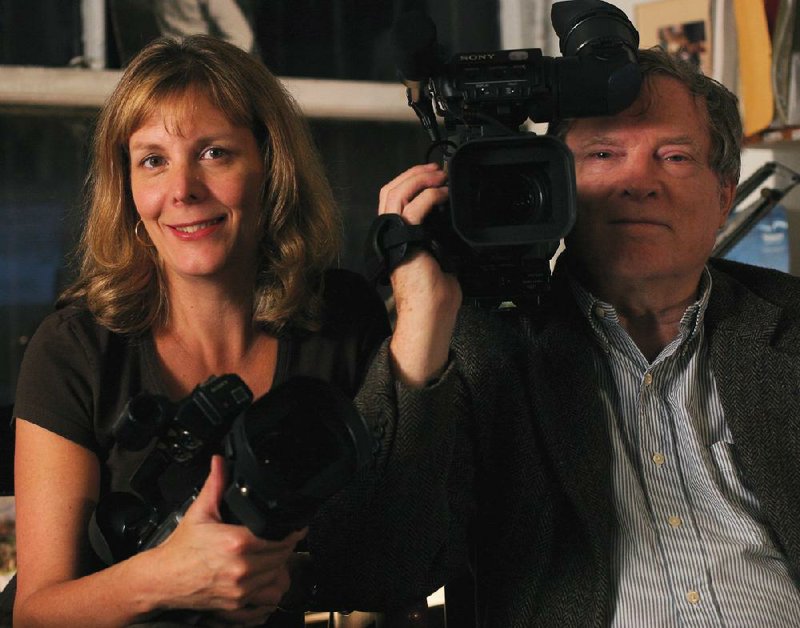LITTLE ROCK — It’s hardly surprising D.A. Pennebaker will become the first documentary filmmaker to receive a Lifetime Achievement Academy Award on Dec. 1. Since 1953, the 87-year-old filmmaker has worked to create fly-on-the-wall documentaries that take viewers into privileged conversations that don’t make it to the evening news.
He contributed to Robert Drew’s Primary, which followed the 1960 Wisconsin primary battle between Hubert Humphrey and John F. Kennedy, and directed Don’t Look Back, which followed Bob Dylan as he was starting to fall in love with electric guitars. He also made concert documentaries like Monterey Pop and Ziggy Stardust and the Spiders From Mars. Alice Cooper, John Lennon and Depeche Mode have also had their shows filmed by him.
And most of his best-known film, 1993’s Oscar-nominated The War Room, which followed strategist James Carville and communications director George Stephanopoulos as they successfully guided then-Arkansas Gov. Bill Clinton to the White House, was shot in Little Rock, in the Arkansas Gazette Building at 112 W. Third St., which is now the home of eStem Public Charter Schools.
Had he stopped making movies in the ’70s, Pennebaker would already have a formidable track record, but he and Chris Hegedus, his wife of 30 years, are responsible for Town Bloody Hall, featuring Norman Mailer, and 2009’s Kings of Pastry (about competing French chefs).
When asked about the honor, Pennebaker admits, “It came out of the blue, so it was like someone had made me a present of an elephant. I wasn’t quite sure what to do about it. [Hegedus] and I adjusted ourselves and accepted it. From what I understand, it was a prize for documentarians.”
“He’s the first documentary filmmaker to get it,” Hegedus adds, “Michael Moore [Fahrenheit 9/11] was really the champion of that. He asked Frazer [Pennebaker’s son] and I if we could supply him with the necessary letters and what else to make this happen. It ended up being a fairly unanimous, easy thing in the end.”
The War Room began as a simple idea.
“We really wanted to see a man becoming president,” Hegedus says. “Penny [Pennebaker] had actually started doing this with Robert Kennedy.”
“I [thought] it was do-able with Bobby,” Pennebaker says. “That was a naive assumption. I’m not sure it’s do-able with anybody normally, because you’re such a small potato compared to what they’re after.”
As for how he managed to do it in The War Room, Pennebaker says, “We would look for cheap flights, and then we would send a fax saying, ‘We’re arriving on such and such a time. If this is not a good idea, let us know.’ Of course, they didn’t read it, much less let us know. And we would just arrive.”
Because Clinton was occupied (he’s seen only in the shadows during the film), Hegedus and Pennebaker chose to focus on Carville and Stephanopoulos. The title refers to the room where Clinton operatives met to respond to attacks or to form strategies. Future Secretary of State Hillary Clinton coined the name.
“She said it would give people the impression that Democrats weren’t wimpy. They were serious,” Hegedus says. Pennebaker and Hegedus were able to catch developments that reporters, who were banned from the room, couldn’t get.
For example, The War Room features Carville reveling in the discovery that the Bush/Quayle campaign had outsourced the printing of their campaign signs to Brazilians.
In the War Room itself, the event seemed decisive, but Hegedus recalls, “That was such an amusing scene for us at so many levels. At the time, I was so excited about it, I remember calling my mom and saying something has happened, and I can’t tell you, but I think Clinton’s going to win. In retrospect, when we talked to James, he said now they’d criticize you for printing in the United States because it costs too much money [laughs].”
Another unguarded exchange featured the seemingly boyish Stephanopoulos (who was 31 at the time) calmly but firmly telling a Ross Perot operative over the phone not to reveal a claim that Clinton had a black illegitimate child. Stephanopoulos took the call on election eve. Without losing his temper, the communications director makes short work of the potential crisis.
Hegedus recalls, “He was very levelheaded and cool in the way he responded to people. James always said something like ...” Pennebaker interrupts, “He said, ‘His IQ could boil water.’”
The new Criterion Collection edition of the film includes a 2008 documentary Return to the War Room, which features Republican operatives Frank Luntz and Mary Matalin, Carville’s wife, explaining why the War Room strategy was so effective. Pennebaker recalls, “People would get prints of The War Room to see what enabled the Democrats to win.”
“Everybody knew the end of our film in some way, so it’s not a cliff hanger. We know that Clinton was going to win. What was really interesting for the press were all these stories that they didn’t know,” Hegedus says.
“We went back to all the people we talked to in The War Room. What we found out was that George and James and [Chicago Mayor] Rahm Emanuel and Dee Dee [Myers] all call each other every morning. It’s like they were the alumni of this fantastic graduation, and they never lost track of each other,” Pennebaker says.
While Pennebaker is now recognized as an important pioneer in documentary filmmaking, his work wasn’t always appreciated. Dennis Stack of the Kansas City Star declared that Don’t Look Back was “The Worst Film I’ve Ever Seen,” and Pennebaker recalls that one reviewer said, “The person who made this film should have his mouth washed out with soap.”
“That was a great advertisement,” Pennebaker says now.
MovieStyle, Pages 35 on 10/19/2012
